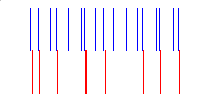Attention - Spike or burst?
How can a neuron hear anything over the cacophony created by ten thousand inputs? A logic gate's handful of inputs pales in comparison. The massive feedback projection from cortex to the thalamus, which relays sensory information, may solve this problem.
Our calculations suggest that fifty spikes arriving within 1ms or seven bursts arriving within 100ms will fire a cortical cell reliably.
Setting a threshold so high that it is rarely exceeded by background activity makes reliable transmission possible. Assume a neuron's 10,000 inputs fire 10 times per second, on average. Then 100±10 spikes (mean ± sigma) occur in 1ms. Hence, the chance that more than 150 spikes (five sigma) are received is just 1%. For a 100ms interval, thresholds of 7 spikes (seven sigma) at each dendritic terminal and 7 active terminals at the soma yield the same probability.
We are investigating how bursting and synchrony can reduce cacophony and boost saliency.
All the neurons in the thalamocortical circuit, including reticular interneurons, which inhibit relay neurons, can burst. But they require a strong input to do so, as a large leak must be overcome. When this leak is turned off, possibly by cortical feedback, the neurons switch their firing mode to single spikes, allowing reciprocal inhibition to synchronize the interneurons, which in turn synchronize the relays.
